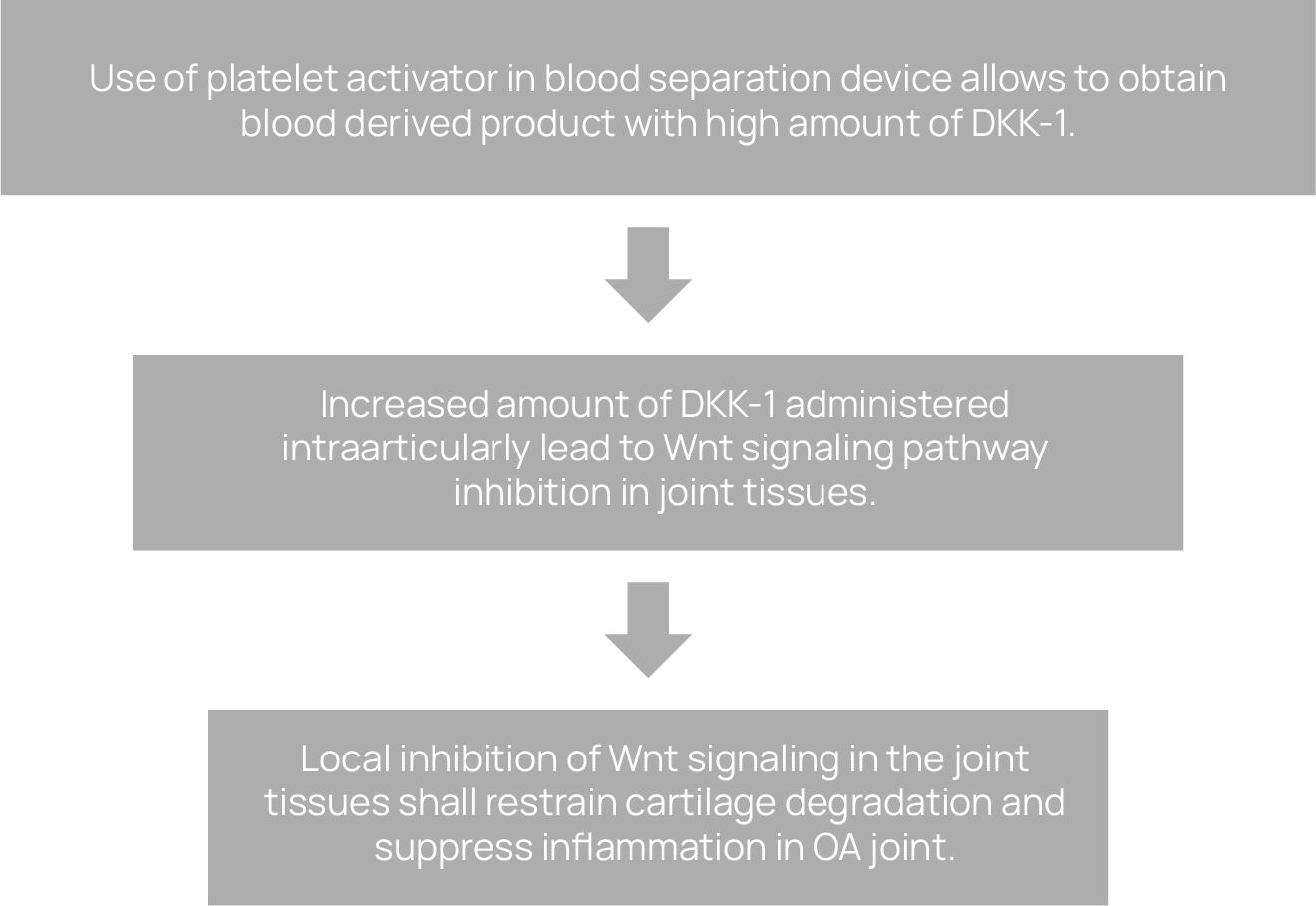OA is a joint disabling disorder with very complex etiology, affecting millions patients worldwide, however without an effective treatment or suitable form of disease restraint.
In a view of growing global health concern in OA, resulting in substantial concern and interest of physicians, scientists, engineers and OA-dedicated societies, we are especially excited to share our unique solution for OA patients, based on molecular inhibition of cellular Wnt signaling pathway that aims to restrain disease development.
Understanding the role of cellular WNT signaling pathway in OA treatment
Osteoarthritis is characterized by the pathological changes in joint tissues, including degradation of cartilage, synovial fibrosis and subchondral bone sclerosis. Combined, those pathologies lead to substantial pain, joint stiffness, and finally to reduced patient mobility.
Wnt signaling pathway emerges as a fundamental regulator of joint tissues development and turnover as it is involved in maintenance and repair of cartilage, synovium and subchondral bone not only during limb development but also in adult musculoskeletal system. Recent evidences from animal experiments and clinical studies confirm the elementary role of Wnt signaling in OA etiology, as dysregulation of members from this pathway has been described as a source pathological changes in the whole synovial joint. This makes the proteins of Wnt-family and signaling pathway an attractive target in potential OA therapy. Unsurprisingly, for the past years, the global direction of OA therapy focused on precise blocking of the overactive canonical Wnt signaling pathway in the synovial joint tissues at the molecular level. Numerous pharma manufacturers stared looking for an effective Wnt signaling pathway inhibitor. Few succeeded and started subsequent clinical trials, however focused only on synthetic molecules.
Following that directions in Biovico we joined this international competition in finding the appropriate Wnt signaling pathway modifier in order to stop its overactivation in OA, however with its own unique strategy.
After years of research Biovico proved that platelets (thrombocytes) can be used as a very efficient source of a biological Wnt signaling pathway inhibitor- a DKK-1 protein. Internal data showed that when appropriately stimulated PLTs can secrete a large amount of DKK-1 that can subsequently be used to block Wnt in OA therapy. Subsequently, based on that knowledge, Biovico created a blood concentration and separation device with exclusive platelet activator in a form of electrostatically charged borosilicate spheres. This device allow to create from patients own blood an injectable product with a very high content of DKK-1.

Consequently, our clinical data provided a solid prove for the clinical functionality of the therapy based on intra-articular injection of blood derived product rich in DKK-1 protein. Biovico’s latest clinical data shed light on the clinical recognition of the anti-Wnt signaling pathway targeted therapy based on blood derived injectable, as innovative and advanced treatment which may stand as a breakthrough in counteracting OA advancement.
Our Approach
1. In-Depth Research: Our dedicated team of scientists and researchers conducted in-depth studies to explore the intricate role of the Wnt pathway in OA and the ability of platelets to release Wnt signaling pathway modifiers. This research was crucial to understand the specific molecular mechanisms and signaling pathways involved.
2. Targeted Therapies: Unlike conventional OA treatments that merely manage symptoms, our solution aims to interfere with molecular mechanism at the cellular level. By inhibiting the Wnt signaling pathway, we aim to stimulate the body's natural ability to modify deleterious mechanism in order to counteract the OA advancement.
3. Clinical Trials We planned and conducted a one year clinical trials to validate the safety and efficacy of our treatment based on blood derived product rich in Wnt pathway inhibitor- DKK1. This trial that involved collaboration with leading medical institutions and experts in the field and show high effectiveness of a single intra-articular injection of the product.
4. Precision Medicine: We are committed to developing personalized treatment strategies. By analyzing the genetic and cellular profiles of OA patients, we can tailor treatment plans to their specific needs. This approach ensures that our solutions are highly effective for each specific patients with different stage or background of the disease.
Our Vision
Our vision is to revolutionize OA treatment by introducing a solution that not only provides relief but also addresses the underlying causes of the condition. By leveraging the cellular Wnt pathway, we aspire to offer hope to OA patients worldwide and enable them to sustain OA and live healthier, more active lives.
The Future of OA Management
As we forge ahead in the development of our cellular Wnt pathway-based solution, we remain dedicated to advancing the field of OA research and providing healthcare professionals with cutting-edge tools to combat this debilitating condition. Our commitment to innovation and patient-centric care drives us to push the boundaries of pharmaceutical development and bring new hope to the world of OA treatment.
Stay tuned for updates on our progress and join us on this journey to redefine the future of OA management through our targeted therapy against Wnt overactivation. Together, we can make a difference in the lives of those affected by OA.